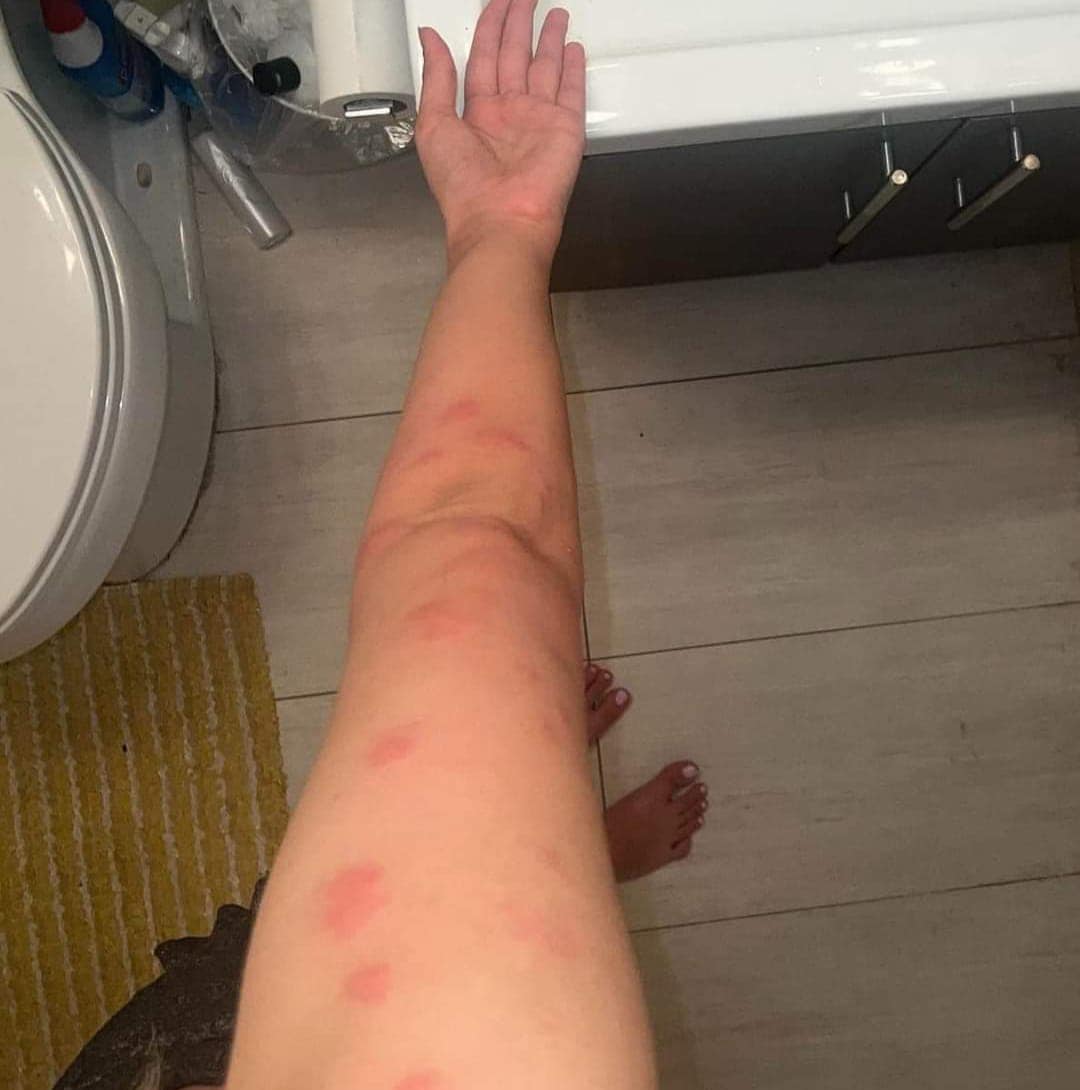ADVERTISEMENT
5. Spider Bites
Appearance: Redness and swelling around a central puncture mark, sometimes with a blister or ulceration.
- Where You Find Them: Anywhere on the body, though often on the arms, legs, or torso.
- What’s Happening: Some spiders, like the black widow or brown recluse, have venom that can cause more serious reactions. Most bites are mild, but certain spiders can cause more severe symptoms.
- Treatment: For most bites, wash the area and apply ice to reduce swelling. For dangerous bites (especially from black widows or brown recluses), seek medical attention immediately.
6. Ant Bites
Appearance: A small, red bump with a white spot in the center (like a blister).
- Where You Find Them: Anywhere on the body, often when walking barefoot or sitting on the ground.
- What’s Happening: Ant bites typically cause a stinging or burning sensation, followed by redness and a raised bump. Certain types of ants, like fire ants, may leave a blister or pus-filled area at the bite site.
- Treatment: Clean the bite with soap and water, apply cold compresses to reduce swelling, and use anti-itch creams. If you’re allergic to ant venom, an antihistamine or epinephrine injection may be necessary.
7. Horsefly Bites
Appearance: A large, red bump that may be swollen and painful.
- Where You Find Them: On the legs, arms, or other exposed areas.
- What’s Happening: Horseflies bite to feed on blood, and their bites can be quite painful. They may cause significant swelling and even bruising.
- Treatment: Clean the bite with antiseptic, apply cold compresses to reduce pain and swelling, and take over-the-counter pain relievers if necessary.
8. Chigger Bites
Appearance: Red, raised welts or clusters of bites, often in a line or around waistbands and socks.
- Where You Find Them: Around the waist, ankles, or where clothing fits tightly.
- What’s Happening: Chiggers are the larvae of mites that feed on skin cells. The bites typically cause intense itching and irritation.
- Treatment: Bathe with soap and water immediately after exposure, and apply anti-itch creams. The bites may last for several days.
9. Lice Bites
Appearance: Small, red, itchy bumps, often clustered around the neck or behind the ears.
- Where You Find Them: On the scalp, neck, and behind the ears.
- What’s Happening: Head lice feed on blood and bite the scalp, causing intense itching. While the bites themselves are small, the itching can be intense.
- Treatment: Use over-the-counter lice treatments to kill the lice and relieve itching. Wash hair thoroughly with medicated shampoo.
10. Mite Bites
Appearance: Small, red, raised bumps that may form a rash or a cluster.
- Where You Find Them: Mite bites can occur on any exposed area of the body, but they are most common in areas where tight clothing or socks are worn.
- What’s Happening: Mites burrow into the skin to lay eggs, causing an itchy, inflamed reaction. Some mites can cause scabies, a contagious skin condition.
- Treatment: Over-the-counter creams, such as hydrocortisone, can help soothe the itch. If you suspect scabies or another skin infection, seek medical treatment for prescription options.
When to Seek Medical Attention
While most bug bites are mild and can be treated at home, there are instances where medical care is necessary:
- Allergic reactions: If you experience severe swelling, difficulty breathing, dizziness, or a rash, seek medical attention immediately. These could be signs of a serious allergic reaction (anaphylaxis).
- Infection: If a bite becomes increasingly red, warm to the touch, or oozes pus, it may be infected. See a doctor if symptoms worsen or if the bite shows signs of infection.
- Unusual symptoms: If you develop flu-like symptoms, fever, or a rash after a bite, especially from ticks or mosquitoes, seek medical attention immediately, as these could be symptoms of a vector-borne disease like Lyme disease or West Nile virus.
Prevention Tips
The best way to deal with bug bites is to avoid them in the first place. Here are some tips to help you stay bite-free:
- Use insect repellent: Apply a bug repellent that contains DEET or natural alternatives like citronella to exposed skin and clothing.
- Wear protective clothing: Long sleeves, pants, and closed shoes can help minimize exposure to insects, especially in areas with high insect populations.
- Avoid peak insect activity times: Many insects, like mosquitoes, are most active at dawn and dusk, so avoid outdoor activities during these times.
- Treat your pets: Pets can bring fleas and ticks into your home, so make sure they are treated regularly with flea and tick prevention products.
Conclusion
Bug bites can be an annoying part of life, but knowing how to identify them can help you determine the best course of treatment. By recognizing the symptoms of common bites, you can better understand what’s causing the irritation and how to prevent future bites. Most bug bites are harmless, but if you experience unusual symptoms or signs of infection, be sure to seek medical attention promptly. With a little knowledge and the right treatment, you can tackle bug bites and get back to enjoying the outdoors in no time!
ADVERTISEMENT
